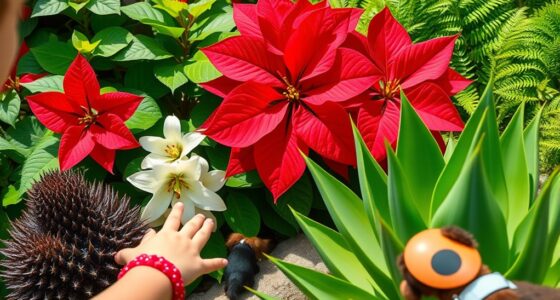For indoor hydroponic systems, you can grow healthy plants using nutrient-rich water solutions and artificial lighting that mimics sunlight. Make certain to select a system that offers uniform light distribution and adjust the light and nutrients as your plants grow. Monitoring pH, EC levels, and system maintenance guarantees ideal conditions, resulting in faster growth and higher yields. Keep exploring to discover the best setup and tips for thriving indoor hydroponic gardens.
Key Takeaways
- Choose grow lights with full-spectrum output to mimic natural sunlight and support healthy plant growth indoors.
- Use water-soluble, balanced nutrient solutions tailored to plant growth stages for optimal development.
- Maintain proper pH (5.5-6.5) and monitor electrical conductivity to ensure nutrient availability.
- Regularly check and adjust lighting, nutrient levels, and system components to prevent issues and maximize yields.
- Select suitable hydroponic systems like nutrient film, deep water culture, or drip systems for efficient indoor plant cultivation.

Have you ever considered growing fresh vegetables and herbs right inside your home? Indoor hydroponic systems make this possible, transforming your living space into a lush, productive garden. To succeed, you need to understand how to optimize light and nutrient delivery for your plants. Light optimization is essential because, unlike outdoor gardening, you rely entirely on artificial lighting to satisfy your plants’ photosynthesis needs. You should select grow lights that emit the full spectrum of light, mimicking natural sunlight as closely as possible. Position your lights at the right distance—usually a few inches above the plants—to prevent stretching or light burn. Keep a consistent lighting schedule, typically 12-16 hours per day, to promote healthy growth and flowering cycles. Adjusting the intensity and duration of your lights based on plant species will guarantee they receive adequate energy without overstimulation. This careful light management encourages robust growth, vibrant leaves, and higher yields. Regularly checking and adjusting your system’s power supply and safety features is also crucial to prevent disruptions or hazards.
Alongside light, nutrient formulation plays a critical role in maintaining a thriving hydroponic system. Since plants in hydroponics depend solely on water-soluble nutrients, you must provide a balanced mix tailored to their specific needs. Commercial nutrient solutions are readily available, but understanding their composition helps you fine-tune your feedings. Focus on key elements like nitrogen, phosphorus, and potassium, which support overall plant health, root development, and flowering. Additionally, trace minerals such as calcium, magnesium, and iron are essential for enzymatic processes and chlorophyll production. Regularly testing your nutrient solution’s pH and electrical conductivity (EC) guarantees maximum absorption. Typically, a pH range of 5.5 to 6.5 is ideal for most vegetables and herbs. If the pH drifts outside this range, your plants won’t absorb nutrients efficiently, leading to deficiencies. Adjusting nutrient formulation based on plant growth stages—more nitrogen during vegetative phases and increased phosphorus and potassium during flowering—can maximize your harvest.
Monitoring and maintaining these conditions—light and nutrients—requires consistent effort but pays off with healthy, vigorous plants. An effective indoor hydroponic system hinges on your ability to optimize light exposure and provide precisely formulated nutrients. When you get these elements right, you’ll notice faster growth, better flavor, and higher yields from your indoor garden. With proper light optimization and nutrient formulation, you’re setting the stage for a successful hydroponic setup that allows you to grow fresh, organic produce year-round, right in your own home.
Frequently Asked Questions
What Are the Best Indoor Hydroponic Systems for Beginners?
You should start with simple, user-friendly indoor hydroponic systems like Kratky or Deep Water Culture setups. These systems promote healthy plant growth and are easy to maintain, making them perfect for beginners. Regular system maintenance involves checking water levels and nutrients, ensuring plants stay healthy. By choosing one of these systems, you’ll enjoy quick results and learn the essentials of hydroponic gardening without feeling overwhelmed.
How Do I Troubleshoot Nutrient Deficiencies in Hydroponic Setups?
When troubleshooting nutrient deficiencies, first check your pH adjustment to guarantee it’s within the ideal range (usually 5.5-6.5). If pH is off, nutrients can’t be absorbed properly. Then, inspect your nutrient supplementation levels—if they’re low, add a balanced nutrient solution. Keep monitoring plants closely, adjusting pH and supplements as needed, to restore healthy growth and prevent deficiencies from worsening.
Can Hydroponic Systems Be Used Outdoors During Winter?
Did you know that over 30% of winter outdoor hydroponic growers face challenges due to cold climates? You can use hydroponic systems outdoors during winter, but you’ll need to safeguard your setup and maintain proper temperature controls to protect plants from freezing temperatures. In cold climates, consider using heated grow mats or greenhouses to extend your growing season and ensure healthy plant growth despite the winter chill.
What Are the Cost Differences Between Various Hydroponic Methods?
When comparing hydroponic methods, you’ll find significant differences in cost. Deep water culture systems usually have lower equipment expenses, making them affordable for beginners. Nutrient film technique setups tend to be pricier due to pumps and grow trays. Ebb and flow systems fall somewhere in between, with moderate equipment costs. Your choice depends on your budget and how much you’re willing to invest, but understanding these costs helps you plan better.
How Often Should I Replace the Water in My Hydroponic System?
Think of your water as the lifeblood of your plants; you should refresh it every 2-3 weeks. Maintaining good water quality is key to healthy growth, so regular system maintenance helps prevent nutrient buildup and algae. Change the water more often if you notice cloudiness or odors. Staying attentive guarantees your hydroponic setup remains vibrant, fostering a thriving indoor garden.
Conclusion
Now that you understand how indoor hydroponic systems work, you can see they’re a smart way to grow plants efficiently. Many believe these systems boost plant growth faster and healthier than soil, and science supports this idea by showing plants absorb nutrients more directly. So, give it a try—you might find that hydroponics not only saves space but also transforms your indoor gardening experience into something truly rewarding. Embrace the method and watch your plants thrive.









